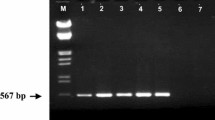Summary
A simple protocol for leaf rooting in beans (Phaseolus vulgaris L.) was developed and used to investigate the reaction of Xanthomonas campestris pv. phaseoli (Xcp), causal pathogen of common bacterial blight disease, in detached versus attached bean leaves. Trifoliate leaves of different sizes (one-third, two-thirds, and fully expanded), either with or without the pulvinus attached to the petioles, were excised from 20 day-old plants of six bean cultivars/lines. Leaf cuttings were cultured in potting medium and then incubated for 5 to 10 days under transparent polyethylene plastic cover in the greenhouse. Roots were readily initiated along the petioles of the leaf cuttings, whether the pulvinus was present or absent. All leaves which were two-thirds expanded and fully expanded developed roots 5 to 7 days after culture. Eighty to 90 percent of the leaves which were one-third expanded formed roots 8 to 10 days after incubation. Laminae of the rooted leaf cuttings were viable and green during the 2 to 3 months period in culture after removing the plastic cover. The common bacterial blight reactions were similar for inoculated attached leaves, detached rooted leaves (inoculated either after or prior to rooting), and moistened detached leaves incubated without rooting. The latter were only usable for evaluation of the Xcp reaction in growth chamber experiments but not under greenhouse conditions. The rooted leaves would be useful for screening bean lines for multiple disease resistance, especially if the pathogens require different environments for disease expression.
Similar content being viewed by others
Abbreviations
- CBB:
-
Common Bacterial Blight
- Xcp :
-
Xanthomonas campestris pv. phaseoli (Smith) Dye
References
Aggour, A.R. & D.P., Coyne, 1989. Heritability, phenotypic correlations, and associations of the common blight disease reaction in beans. J. Amer. Soc. Hort. Sci. 114: 828–833.
Andrus, C.F., 1948. A method of testing beans for resistance to bacterial blights. Phytopathology 38: 757–759.
Arnaud-Santana, E., 1992. Genetics and breeding for resistance to common blight, web blight, and rust diseases in dry beans (Phaseolus vulgaris L.). PhD Diss., Univ. of Nebraska, Lincoln, Neb. USA.
Arunakumari, A. & A.K., Vidaver, 1986. Identification of Xanthomonas campestris pv. phaseoli mutants with altered pathogenicity using a detached bean leaflet bioassay. Phytopathology 76: 1136 (Abstr.).
Blomgren, S.M., L.A., Amberger, H.E., Heer & R.C., Palmer, 1988. A petiole-rooting technique for soybean chromosome observation. Soybean Genetics Newsletter. 15: 153–154.
Claflin, L.F., A.K., Vidaver & M., Sasser, 1987. MXP, a semi-selective medium for Xanthomonas campestris pv. phaseoli. Phytopathology 77: 730–734.
Coyne, D.P. & M.L., Schuster, 1983. Genetics of and breeding for resistance to bacterial pathogens in vegetable crops. HortScience 18: 30–36.
Gomez, K.A. & A.A., Gomez, 1984. Statistical procedures for agricultural research, 2nd ed. John Wiley & Son, New York.
Humphries, E.C., 1963. Dependence of net assimilation rate on root growth of isolated leaves. Ann. Botany 27: 175–183.
Humphries, E.C., 1967. The effect of different root temperatures on dry matter and carbohydrate changes in rooted leaves of Phaseolus Spp. Ann. Botany 31: 59–69.
Lie, T.A., 1971. Nodulation of rooted leaves in leguminous plants. Plant & Soil. 34: 663–673.
McElroy, J.B., 1985. Breeding dry beans (Phaseolus vulgaris L.) for common bacterial blight resistance derived from Phaseolus acutifolius A. Gray. PhD Diss., Cornell Univ. Ithaca, N.Y.
SAS Institute Inc., 1982. SAS user's guide: Statistics, 1982 (ed). SAS Institute, Inc. Cary, N.C.
Schuster, M.L. & D.P., Coyne, 1981. Biology, epidemiology, genetics and breeding for resistance to bacterial pathogens of Phaseolus vulgaris L. Hort. Rev. 3: 28–57.
Yoshii, K., 1980. Common and fuscous blights, p. 155–172. In: H.F., Schwartz & G.E., Galvez (Eds.). Bean production problems. Centro Internacional de Agricultura Tropical (CIAT), Cali, Colombia.
Zaumeyer, W.J. & H.R. Thomas, 1957. A monographic study of bean diseases and methods for their control. USDA Tech. Bul. 868.
Author information
Authors and Affiliations
Rights and permissions
About this article
Cite this article
Mohamed, M.F., Arnaud-Santana, E. & Coyne, D.P. Rooting of bean leaves and use in germplasm evaluation for common bacterial blight resistance. Euphytica 65, 161–166 (1992). https://doi.org/10.1007/BF00023079
Received:
Accepted:
Issue Date:
DOI: https://doi.org/10.1007/BF00023079




